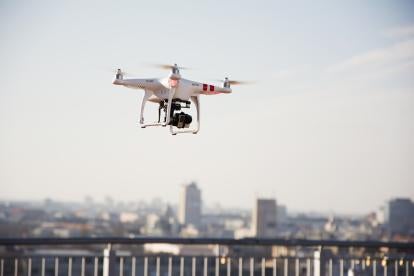On December 28, 2020, the FAA issued a new rule, published in the Federal Register on January 15, 2021, which will impose a requirement (subject to two exceptions described below) for every unmanned aircraft weighing over 0.55 pounds and operated in U.S. navigable airspace to incorporate a remote identification capability so that it can be tracked in U.S. air traffic. The new rule takes effect 60 days after publication in the Federal Register, but operators of unmanned aircraft have 30 months to bring their operations into compliance with the new rule. Manufacturers of unmanned aircraft have 18 months to incorporate such systems into the unmanned aircraft they manufacture.
The preface to the new rule explains that it represents “the next incremental step” toward enabling routine operations of unmanned aircraft over people and beyond the visual line of sight (think, for example, the potential routine use of unmanned aircraft by a company like Amazon to deliver packages). The FAA published a brief description of the new rule on its website.
Subject to limited exceptions, the new rule requires unmanned aircraft registered under part 47 or 48 and operated in U.S. airspace to have a remote identification system meeting FAA requirements. 14 C.F.R. §§ 89.101, 89.105. This requirement can be fulfilled either of two ways:
-
The operator can use an unmanned aircraft that incorporates a remote identification feature as original equipment. This is known as a “standard remote identification unmanned aircraft.” § 89.110. In this case, the operator must ensure that the aircraft either is listed on an FAA declaration of compliance or is covered by an FAA design approval under part 21, and the serial number that includes the remote identification capability is provided to the FAA either at the time of the aircraft’s registration or in a notice of identification filed under section 89.130 prior to operation. The operator must, of course, also ensure that the remote identification feature is not disabled and is broadcasting the required message elements listed in section 89.305 (these include a unique identifier; an indication of the control station’s latitude, longitude, and geometric altitude; an indication of the unmanned aircraft’s latitude, longitude, and geometric altitude; an indication of the velocity of the unmanned aircraft; a time mark; and an indication of the emergency status of the unmanned aircraft). In this case, there is no requirement for the operator always to maintain a line of sight to the aircraft. The concept is that the FAA will be approving designs of unmanned aircraft with remote identification systems that will enable the unmanned aircraft to operate safely without that line of sight.
-
Alternatively, the operator can equip an unmanned aircraft with a “remote identification broadcast module.” § 89.115. In this case, the operator must ensure that the module meets the requirements of section 89.320, that the module serial number is listed on a declaration of compliance, and that the serial number of the module is either in the aircraft’s registration or in a notice of identification filed under section 89.130 prior to operation. The operator must also ensure that the remote identification feature is not disabled and is broadcasting the required message elements listed in section 89.315 (these include a unique identifier; an indication of the unmanned aircraft latitude, longitude, and geometric altitude; an indication of the unmanned aircraft take-off location latitude, longitude, and geometric altitude; an indication of the unmanned aircraft velocity; and a time mark). In this case, the operator must always maintain a line of sight to the aircraft.
Only two exceptions are allowed to these new remote identification requirements, as follows:
-
First, operation without remote identification will be allowed in FAA-recognized identification areas (“FRIAs”) § 89.115(b). These areas will be the subject of approvals issued by the FAA under section 89.215. These FRIAs will be limited to areas established by community based organizations or educational institutions.
-
Second, under section 89.120, the FAA “may authorize operations without remote identification where the operation is solely for the purpose of aeronautical research or to show compliance with regulations.”
The unmanned aircraft remote identification requirement cannot be met by the use of existing transponders or ADS-B systems used by manned aircraft. The rule, in fact, prohibits the use of such systems by unmanned aircraft (except in special flight plan operations approved by the FAA) in order to prevent the saturation of existing frequencies by unmanned aircraft, which could negatively affect the safety of manned aircraft operations. §§ 107.52, 107.53. This prohibition takes effect 60 days after publication of the new rules.
The rule provides that the FAA will accept applications describing remote identification systems for “acceptance” by the FAA as fulfilling the performance requirements established by the rule. The FAA then will publish a list of these accepted remote identification systems. Under new section 89.530, the producer of a standard remote identification unmanned aircraft or a remote identification broadcast module must submit a declaration of compliance to the FAA confirming that its standard remote identification unmanned aircraft or a remote identification broadcast module complies with the rule.
Companies that are currently operating registered unmanned aircraft can continue operating them for 30 months, but must bring them into compliance with the remote identification requirement of the new rule within that period in order to continue operations after the 30 months expire – unless they limit operations to FRIAs or the special, FAA-approved research or compliance activity referred to in section 89.120.
At the time of registering an unmanned aircraft, the applicant will be required to provide information concerning remote identification as follows:
(6) For any standard remote identification unmanned aircraft, the serial number issued by the manufacturer of the unmanned aircraft in accordance with the design and production requirements of part 89 of this chapter. The serial number provided in this application must not be listed on more than one Certificate of Aircraft Registration at the same time.
(7) For any unmanned aircraft equipped with a remote identification broadcast module, the serial number issued by the manufacturer of the remote identification broadcast module in accordance with the design and production requirements of part 89 of this chapter. An applicant may submit the serial number of more than one remote identification broadcast module as part of the application for aircraft registration under § 48.105. The serial number of a remote identification broadcast module provided in this application must not be listed on more than one Certificate of Aircraft Registration at the same time.
In light of this new rule, designers, manufacturers and operators of unmanned aircraft need to begin planning how they will implement remote identification into their products and operations, and those doing R&D need to consider the locations where they are doing their test flights and determine whether they could become FRIAs or fit the aeronautical research exception. Companies that have been using transponders or ADS-B for unmanned aircraft will also need to bring their activities into compliance with the new restrictions on those operations.



 />i
/>i

